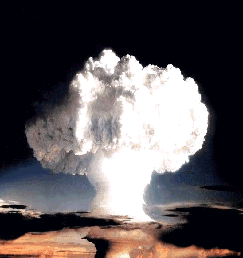Nuclear Detonation:
Weapons, Improvised Nuclear Devices
- Nuclear Detonation: General Information
- Improvised Nuclear Devices (INDs)
- Expected Timeline of Events
- Categories of Medical Effects
- Medical Management
- Communicating After an IND Detonation: Resource for Responders and Officials
- Shelter in Place: Shielding by Buildings from Fallout and Blast
- Numbers and Types of Casualties from Various Computer Modeled Nuclear Detonation Scenarios
- Radioactive Fallout
- Selection of Radiation Detection Systems
- Historical Nuclear Testing Film Clips and Nuclear Safety Films
- Key References
Nuclear Detonation: General Information 3
Figure 5. Approximate distances for zones with varying yield nuclear explosions
Second edition, 6/2010 |
Figure 1. Nuclear explosion: mushroom cloud Figure 2. Nuclear weapon explosion effects: approximate 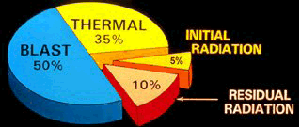 Source: Armed Forces Radiobiology Research Institute's Medical Effects of Ionizing Radiation Course on CD-ROM (1999) Figure 3. General patterns of damage from a 10-Kt nuclear explosion on the ground 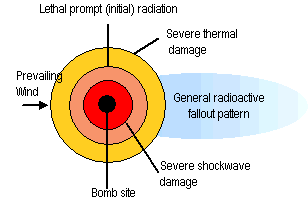 Source: The National Academies and the U.S. Department of Homeland Security Figure 4. Damage zones after a nuclear detonation: idealized maps 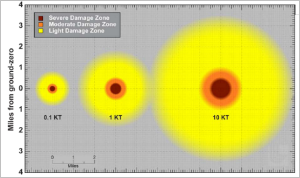 Source: Planning Guidance for Response to a Nuclear Detonation, Second edition, 6/2010 Figure 6. Impacts of peak overpressure of blast
| |||||||||||||||||||||||||||||||||||||||
Figure 7. Fallout: Relative rate of decline of radioactivity after a nuclear explosion
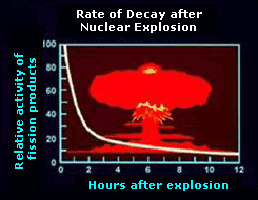 |
|
| Source: Armed Forces Radiobiology Research Institute's Medical Effects of Ionizing Radiation Course on CD-ROM (1999) | |
Figure 8. Factors that affect fallout
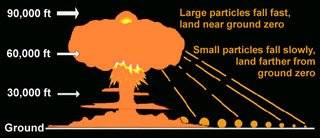 |
Particle size: Assuming constant wind and altitude, larger particles land relatively close to ground zero and smaller particles land farther away. |
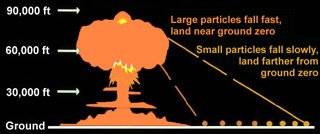 |
Altitude: The higher the initial altitude of a particle, the farther away from ground zero it lands, assuming constant wind speed and particle size. This means that the fallout pattern will be different if there is a ground burst vs. one from an altitude, and increasing altitude will also affect the fallout pattern. |
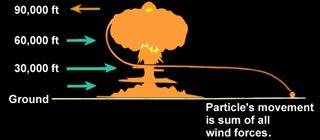 |
Wind: Wind is the most difficult factor to predict. Different altitudes through which a particle falls may have different wind speeds and directions that affect the final destination of the fallout particle. This explains how fallout can occur miles upwind of a detonation. |
Improvised Nuclear Devices (INDs) 4, 8
- An illicit nuclear weapon bought, stolen, or otherwise originating from a nuclear state, or a weapon fabricated by a terrorist group from illegally obtained fissile nuclear weapons material that produces a nuclear explosion
- Built from the components of a stolen weapon or from scratch using nuclear material (plutonium or highly enriched uranium)
- Produces same physical and medical effects as nuclear weapon explosion
- Results in catastrophic loss of life, destruction of infrastructure, and contamination of a very large area
- If nuclear yield is NOT achieved, the result would likely resemble a Radiological Dispersal Device in which fissile weapons material was dispensed locally
- If nuclear yield is achieved, results would resemble a nuclear explosion described on this page
- Like nuclear explosions, IND explosions can be evaluated with a fallout map (See Fallout Map 1, Fallout Map 2)
Reference: Planning Guidance for Protection and Recovery Following Radiological Dispersal Device (RDD) and Improvised Nuclear Device (IND) Incidents (PDF - 519 KB) (DHS/FEMA, published in Federal Register, August 1, 2008, Z-RIN 1660-ZA02) The preceeding document has been superseded by the following: Planning Guidance for Response to a Nuclear Detonation, Second edition, 6/2010 (PDF - 2.62 MB) (National Security Staff, Interagency Policy Coordination Subcommittee for Preparedness & Response to Radiological and Nuclear Threats)
Expected Timeline after IND Detonation
Expected Timeline of effects of a 10-Kiloton Improvised Nuclear Device Detonation
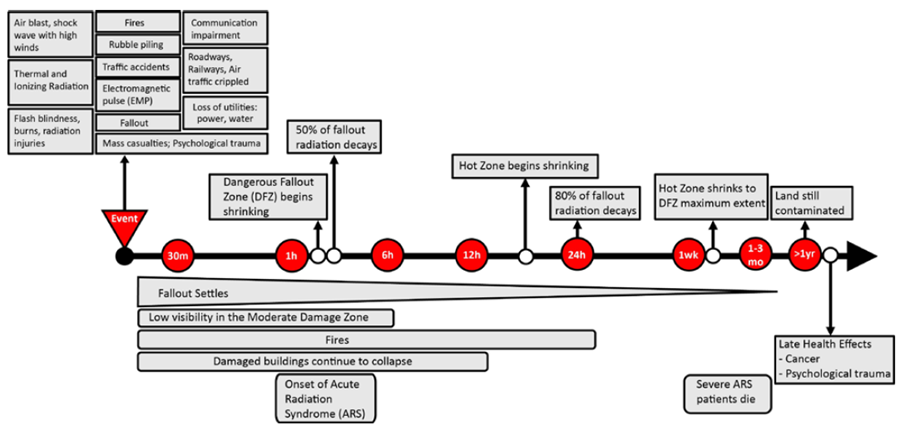
- The graphic above is from the 2016 version of the Nuclear/Radiological Incident Annex to the Response and Recovery Federal Interagency Operations Plan (PDF - 3.38 MB) (See Appendix 1 to Branch 1, page 26) (US Government Interagency, October 2016)
- Note: The Nuclear/Radiological Incident Annex was Updated in 2023. The 2023 version does not contain an equivalent timeline of expected effects of a 10-kt Improvised Nuclear Detonation.
- The text after the graphic in the 2016 Annex explains the terms in the graphic.
- See also: More REMM information about timelines describing radiation incidents including incidents other than nuclear detonations.
Categories of Medical Effects
Blast injury | Thermal/burn injury | Radiation injuries- Blast injury
- Immediate effects of blasts and explosions
- Primary blast injury — direct effects result from barotrauma (e.g., overpressurization and underpressurization) commonly affecting air-filled organs and air-fluid interfaces (Figure 9)
- Rupture of tympanic membranes: Injury to ear drum: 5 psi
- Pulmonary damage: Injury to lung: 15 psi
- Rupture of hollow viscera: Injury fatal (LD50): 50 psi
- Secondary blast injury
- Penetrating trauma
- Fragmentation injuries
- Tertiary blast injury — effects of structural collapse and of persons being thrown by the blast wind
- Crush injuries and blunt trauma
- Penetrating or blunt trauma
- Fractures and traumatic amputations
- Open or closed brain injuries
- Quaternary blast injury — burns, asphyxia, and exposure to toxic inhalants
- Primary blast injury — direct effects result from barotrauma (e.g., overpressurization and underpressurization) commonly affecting air-filled organs and air-fluid interfaces (Figure 9)
- Types of injuries caused by blasts depend on whether blasts
- Occur outdoor in open air or within buildings
- Cause the collapse of a building or other structure
- Conventional bombs generate blast waves that spread out from a point source
- Blast wave consists of two parts
- Shock wave of high pressure followed by
- Blast wind or air in motion
- Damage produced by blast waves decrease exponentially with distance from the point source
- Reverberations occur off walls and rigid objects
- As outward energy dissipates, a reversal of wind back toward the blast and underpressurization occur
- The resulting pressure effect damages organs, particularly at air-fluid interfaces, and the wind propels fragments and people, causing penetrating or blunt injuries
- Blast wave consists of two parts
- Enhanced-blast explosive devices (e.g., nuclear explosions) have more damaging effects than conventional explosions
- Primary blast disseminates the explosive and then triggers it to cause a secondary explosion
- High pressure wave then radiates from much larger area, prolonging the duration of the overpressurization phase and increasing the total energy transmitted by the explosion
- Cause a greater proportion of primary blast injuries than do conventional devices
- Immediate effects of blasts and explosions
- Thermal/burn injury
- Direct absorption of thermal energy through exposed the skin or heating or ignition of clothing (flash burns) (Figure 10)
- Indirect action of fires caused in the environment (flame burns)
- Burn casualties — and it is expected there would be many — may result from the absorption of thermal radiation energy
- Eye injuries
- Flash blindness (See illustration)
- Caused by the effect on the retina of the initial brilliant flash of light produced by the explosion
- Victims DO NOT have to be looking at the detonation site, as reflected/diffracted light is sufficient in many cases
- Victims driving at the time of the event will be unable to see, potentially causing large numbers of traffic accidents
- During daylight, flash blindness does not persist for greater than about 2 minutes, but lasts generally seconds
- At night, when the pupil is dilated, flash blindness will last longer
- Partial recovery may be expected within 3-10 minutes in daylight, longer at night
- Retinal scarring
- Retinal burn (See illustration) resulting in permanent damage from scarring results when a fireball is directly viewed
- May be sustained at considerable distances from the explosion, depending on blast size
- Location of the scar will determine the degree of interference with vision
- Central scarring will cause greater disability
- Flash blindness (See illustration)
- Radiation injuries
- During the incident
- Prompt radiation
- Gamma and neutron radiation exposure dose received within the first minutes after detonation
- Depending on dose, patients are at risk for Acute Radiation Syndrome
- Delayed radiation
- Fallout (Figure 7, Figure 8): Produced by fission products and neutron-induced radionuclides in surrounding materials (water, soil, structures, nuclear device debris)
- These radioactive products will be dispersed downwind with the fireball/debris cloud (Figure 7, Figure 8)
- As the cloud travels downwind, the cooling and falling radioactive material settles on the ground, creating a large swath of deposited material (fallout) (Figure 7, Figure 8)
- The highest concentrations (creating the most dangerous radiation levels) fall closest to the detonation site
- The fallout creates large areas of contamination, and the ionizing radiation coming off the fallout contamination damages tissue and can penetrate through thin walls and glass
- Three ways victims can get a dose of radiation from the fallout:
- Radiation directly from the fallout as it passes by or from the fallout that has been deposited on the ground
- Radiation from fallout contamination on skin, clothing, or possessions, which exposes people until they change their clothing and/or remove the contaminated material
- Ingestion or inhalation of radioactive material
- Of these, the most likely to cause injury in the first few days is direct exposure to fallout, which can be protected against using the three basic principles of time, distance, and shielding
- Exposure to fallout is the most dangerous in the first few hours
- Fallout decays rapidly with time:
- Example from a hypothetical 10 Kt explosion:
- After 3 hours, initial exposure rates are down to 20%
- 8 hours, down to 10%
- 48 hours, down to 1%
- Therefore, sheltering for the first few hours can save lives
- Example from a hypothetical 10 Kt explosion:
- Prompt radiation
- Long after the incident (potential long-term effects of radiation)
- Delayed effects of acute radiation exposure
- Specific organ effects depending on where a given isotope is incorporated
- Carcinogenesis
- Mutagenesis (fetal effects)
- During the incident
|
Figure 9. Blast Injuries 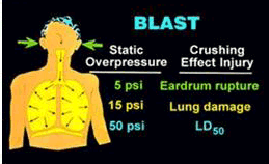 Source: Armed Forces Radiobiology Research Institute's Medical Effects of Ionizing Radiation Course on CD-ROM (1999) psi = pounds per square inch LD50 = the dose of radiation expected to cause death to 50% of those exposed without medical treatment. |
Figure 10. Thermal burn on skin from nuclear explosion 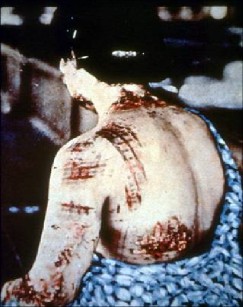 Source: Pictures of World War II, U.S. National Archives & Records Administration, 77-MDH-6.55b Skin burn pattern corresponding to the dark portions of a kimono worn at the time of the atomic explosion, 1945. |
Medical Management 3, 4, 9, 10, 22 - 30
- Both exposure
and contamination can occur.
- See sections of this Web site for diagnosis and treatment of
- Initial Actions for Responders after Nuclear Detonation
- First Receivers: Emergency Department Staff: 2 page summary sheet (US Government Interagency, May 2014, Version 1.0, Draft for Interim Use) (PDF - 1 MB)
- First Responders: Emergency Medical Service Staff: 2 page summary sheet (US Government Interagency, May 2014, Version 1.0, Draft for Interim Use) (PDF - 1.02 MB)
- Just-in-time Training for Healthcare Providers after the Detonation of an IND (RITN) (YouTube - 16:10 min)

- Radiation injury
- Since the event is likely to be a mass casualty situation, the procedures used for diagnosis and treatment of patients may need to be modified from those recommended in events with a smaller number of victims
- Triage
- Mass casualty issues after radiation exposure
- Treatment of Acute Radiation Syndrome: modifications in mass casualty situations with scarce resources
- Triage category and cytokine use after a nuclear detonation (Interactive tool)
- Hick JL, Bader JL, Coleman CN, et al. Proposed "Exposure And Symptom Triage (EAST)" Tool to Assess Radiation Exposure After a Nuclear Detonation. Disaster Med and Public Health Preparedness published online 31 July 2017.
- EAST Tool and Notes: can print normal size or make large poster for wall (2 pages)
- Biodosimetry tools: calculating dose from exposure (Interactive tool)
- Burn triage and treatment
- Where to send biodosimetry specimens
Communicating After an IND Detonation: Resource for Responders and Officials
- Communicating in a Nuclear Disaster: Observations from COVID-19 (July 2020) (Zoom recorded video by Vivi Siegel (CDC) and Jessica Wieder (EPA) hosted on NACCHO platform (1 hour 5 min)

- A Decision Makers Guide: Medical Planning and Response for a Nuclear Detonation (HHS/ASPR, November 2017)
- Information sheets for the general public
- Overview of Briefing Products: Part 1: Radiological and Nuclear (HHS and DOE/LLNL, Dec 17, 2014)
- Provides examples of maps and dose information that will be produced by National Atmospheric Release Advisory Center (DOE/NARAC) after a radiation incident to help responders manage health effects, levels, and protective action recommendations.
- Improvised Nuclear Device Response and Recovery: Communicating in the Immediate Aftermath (US Government Interagency Nuclear Detonation Response Communications Working Group, April 2024)
- Example of a Lifesaving Message that Could be Broadcast Immediately After and Improvised Nuclear Detonation (Source: Medical Planning and Response for a Nuclear Detonation: a Practical Guide, Biosecurity and Bioterrorism: Biodefense Strategy, Practice, and Science 2012; 10(4):346-371. See Figure 10.
Shelter in Place: Shielding by Buildings from Fallout and Blast
Buildings provide considerable protection from fallout (Figure 11), and blast (Figure 12)
- A brick building provides better protection from radiation (Figure 11) and blast (Figure 12) than does a brick veneer building, which is better than that of a frame building.
- Less radiation exposure (increasing the Protection Factor) is seen at interior locations and below ground
- The multiple-story office building illustration below shows that the middle floors provide better shielding than the ground floor or exterior locations because fallout that emits gamma radiation covers the ground, exterior surfaces, and the rooftop.
- Moving to a higher floor in the building increases the distance from the ground source but increases exposure from radiation on the rooftop.
References:
- Sheltering in Place During a Radiation Emergency (HHS/CDC, May 2006)
- Dillon MB, Determining optimal fallout shelter times following a nuclear detonation. Proceedings of the Royal Society A. Proc. R. Soc. 2014; 470:20130693 (Note: This article reviews/analyzes several other recent publications on this topic. This article proposes modifications to the standard shelter-in-place guidance, based on the "timing and conditions under which poorly sheltered individuals should leave their shelters to evacuate or obtain better shelter". This recommendation is currently being reviewed by US government agencies.)
- Design Guidance for Shelters and Safe Rooms: Risk Management Series (PDF - 12.8 MB) (DHS/FEMA 453, May 2006)
- Shelter in Place (Preparedness 360)
- Sheltering and Evacuating of Cities After an IND: Analyses from Sandia National Laboratories
- Larry D. Brandt, Ann S. Yoshimura, Analysis of Sheltering and Evacuation Strategies for an Urban Nuclear Detonation Scenario, (PDF - 2.07 MB) SAND2009-3299, May 2009
- Larry D. Brandt, Ann S. Yoshimura, Analysis of Sheltering and Evacuation Strategies for a National Capital Region Nuclear Detonation Scenario, (PDF - 1.64 MB) SAND2011-9092, December 2011
- Larry D. Brandt, Ann S. Yoshimura, Analysis of Sheltering and Evacuation Strategies for a Chicago Nuclear Detonation Scenario, (PDF - 1.41 MB) SAND2011-6720, August 2011
Figure 11. Buildings as radiation shielding
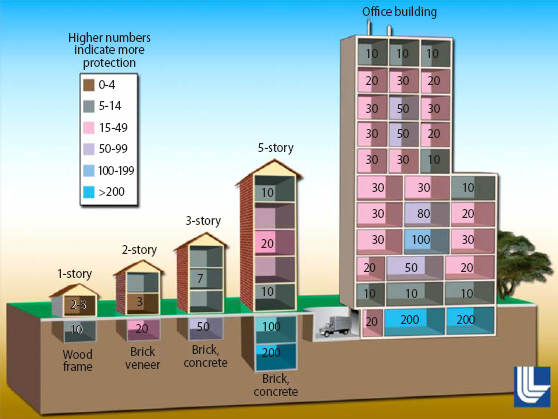
Figure 11: Example protection factors (PFs) for a wide variety of building types and locations.
- Numbers represent a "dose reduction factor".
- A dose reduction factor of 200 indicates that a person in that area would receive 1/200th of the dose of a person out in the open.
Figure 12. Selecting a safe room after an IND detonation
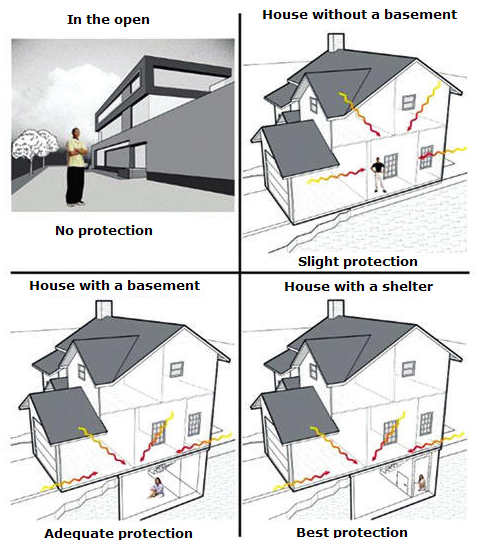
Source: Coleman CN, Adams S, Adrianopoli C, Ansari A, Bader JL, et al., Medical planning and response for a nuclear detonation: a practical guide. Biosecur Bioterror. 2012 Dec;10(4):346-71. (Figure 4) [PubMed Citation]
Figure 13. Blast Effects on Dwellings

Numbers and Types of Casualties from Various Computer Modeled Nuclear Detonation Scenarios
- Table estimating medical casualty numbers and types after an IND detonation (PDF - 608 KB):
important caveats about casualty numbers in this table- Generated expressly for the "Scarce Resources for a Nuclear Detonation Project", for the purpose of assisting with medical response planning.
- Adapted from Knebel AR, Coleman CN, Cliffer KD, Murrain-Hill P, McNally R, Oancea V, Jacobs J, Buddemeier B, Hick J, Weinstock D, Hrdina CM, Taylor T, Matzo M, Bader JL, Livinski A, Parker G, Yeskey K. Allocation of Scarce Resources Following a Nuclear Detonation: Setting the Context. Disaster Med Public Health Prep. 2011 Mar;5 Suppl 1:S20-31. [PubMed Citation], Full Text (PDF - 457 KB)
- Do not represent comprehensive modeling for all potential consequences of a nuclear detonation.
- Do not represent data for any specific city
- Represent only a general order of magnitude useful for medical resource planning considerations
- Represent US government interagency computer modeling and calculations of 185 distinct nuclear detonation scenarios using many variables including
- Nuclear detonation yields (0.1-10 kT)
- Heights of burst (ground and air)
- Weather conditions
- US cities
Radioactive Fallout
- See detailed information and graphics about fallout from an important new US government monograph from 2019.
-
After and IND, radioactive material that returns to the ground after it is propelled into the atmosphere is called "fallout".
- Winds at high levels above ground can carry the radioactive material far from the detonation site.
- Low-level winds do not predict the direction of fallout.
- These radioactive clouds have been called the "plume", and the radiation emitted from these "plumes" has been called "cloud shine".
- When radioactive fallout is deposited on the ground and on buildings, the resulting radiation has been called "groundshine".
- See computer model example of fallout/goundshine at 2 hours after detonation of nuclear device.
- See computer model of fallout and other effects 2 hours after detonation of a 10 kT nuclear device on the ground.
-
See video: Nuclear Detonation Fallout (YouTube - 1:30 minutes) (U.S. Government archive)

- See illustration: Fallout shrinks over time due to radioactive decay (Lawrence Livermore National Laboratory)
-
The level of radiation in the environment can be predicted and estimated by computer modeling and actual measurements.
- Models use information about the size of the crater, height of the mushroom cloud, weather, topography, principles of physics, results from radiation detectors in the air and on the ground, and other parameters.
-
Official government response teams use these tools to create maps of areas expected to be contaminated by fallout and predict how radiation levels are expected to change over time. This will help direct appropriate response activities.
- A map predicting or reflecting actual radiation levels displays a specific geographic area overlaid with lines or areas of similar exposure or dose.
- This mapping is similar to a weather map displaying isotherms or isobars.
-
The geographic location of the dose or exposure rate/hour lines from groundshine
- Will change over time, as
- The radioactive isotopes in fallout decay quickly
- See short movie showing rapidly shrinking dangerous fallout zone after an IND (YouTube - 0:29 minutes)

-
Potential medical issues from fallout: brief overview
- Exposure to radiation from fallout in the first few days is expected to be a far more serious clinical public health problem than either external or internal contamination.
- A nuclear explosion produces more than 300 isotopes in the fission process and other radioactivity induced by neutrons.36.
-
The four significant nuclides that accounted for nearly three-fourths of the reconstructed whole-body internal dose to people who lived within a few hundred kilometers of one Nevada Test Site were identified as Sr-89, Sr-90, I-131, and Cs-137.37
- The majority of internal contamination of individuals in one key study occurred from eating contaminated food. 36
- With respect to human uptake of fallout products, ingestion of radioisotopes is likely to be a much greater medical concern than inhalation. 37
-
Minimizing risk from fallout: general principles
-
External exposure from fallout is the most serious radiation-related medical concern for those walking through a fallout area or sheltering in a place with an inadequate Protection Factor.
- After a nuclear detonation, prolonging the time of sheltering-in-place (for at least 24 hours when possible) in a building with a high Protection Factor will minimize this risk, as radiation decays quickly over time.
- Those receiving a whole body dose from exposure of = 200 cGy may need urgent evaluation and possibly treatment for Acute Radiation Syndrome.
-
External contamination is likely for those who walk through a fallout field after a nuclear detonation.
- Prolonging the time of sheltering-in-place (for at least 24 hours when possible) after the detonation will minimize the medical risk, as the radiation decays quickly over time.
- First responders would be expected to use Personal Protective Equipment (PPE) appropriate for their role and hazard.
- External decontamination should be performed as soon as feasible for anyone with external contamination.
-
Internal contamination via inhalation and/or ingestion could result from walking through a fallout field like the Dangerous Fallout Zone, inhaling radioactive dust, or consuming contaminated food and liquids.
- Wearing PPE with respiratory protection and not eating contaminated food or liquids should alleviate or minimize this problem. Radioactive dust is about the size of sand particles, which would be unlikely to travel deep into the lungs.
- Prolonging the time of sheltering-in-place (for at least 24 hours when possible) after the detonation will minimize this risk, as the fallout decays quickly over time.
- First responders would be expected to use formal respiratory protection to minimize the risk from inhalation.
- Those without access to formal respiratory protection could use informal protection like a handkerchief across the nose and mouth.
- Avoiding eating contaminated food and drink is the most effective Protective Action in this circumstance.
- Public health officials may recommend medical countermeasures for internal contamination in very specific circumstances.
-
External exposure from fallout is the most serious radiation-related medical concern for those walking through a fallout area or sheltering in a place with an inadequate Protection Factor.
-
See also:
- Adams TG, Yeddanapudi N, Clay M, Asher J, Appler J, Casagrande R. Modeling Cutaneous Radiation Injury from Fallout. Disaster Med Public Health Prep. 2019;13(3):463-469. [PubMed Citation]
- Time Sequenced Size of Dangerous Fallout Zone and 0.01 R/Hour Boundary after a Hypothetical 10kT Nuclear Detonation at Ground Level
- Approximate prompt and delayed fallout effects from a 10 kT detonation
- Rapidly shrinking dangerous fallout zone after an IND (YouTube - 0:29 minutes)

- Can You Survive Nuclear Fallout? [TED-Ed Talk, Jan 8, 2019, created by Brooke Buddemeier (DOE/LLNL) and Jessica S. Wieder (EPA), narrated by Addison Anderson]. (YouTube - 5:24 min)

Historical Nuclear Testing Film Clips and Nuclear Safety Films
- YouTube channel with many archived videos of historical detonations. (YouTube)
- Nuclear Detonation Fallout (YouTube - 1:30 minutes) (U.S. Government archive)

- Nuclear Detonation Effects (YouTube - 0:41 minutes) (U.S. Government archive)

Key References
Federal Guidance Documents
- A Decision Makers Guide: Medical Planning and Response for a Nuclear Detonation (HHS/ASPR, November 2017)
- Nuclear/Radiological Incident Annex to the Response and Recovery Federal Interagency Operations Plan (PDF - 3.38 MB) (US Government Interagency, 2023)
- Glasstone S, Dolan PJ, The Effects of Nuclear Weapons, (PDF - 31 MB), 3rd ed. Washington, D.C.: US Government Printing Office, 1977.
- Planning Guidance for Response to a Nuclear Detonation, Second edition, 6/2010 (PDF - 2.62 MB) (National Security Staff, Interagency Policy Coordination Subcommittee for Preparedness & Response to Radiological and Nuclear Threats)
- Quick Reference Guide: Radiation Risk Information for Responders Following a Nuclear Detonation (PDF - 913 KB) (US Government Inter-agency Collaboration, December 2016)
- This document supports the Planning Guidance for Response to a Nuclear Detonation (Second Edition, June 2010) and was designed to provide responders with specific guidance and recommendations about the radiation risk associated with responding to an improvised nuclear device (IND) event, in order for them to protect themselves from the IND effects.
- It is intended to be part of preparation training with the "Health and Safety Planning Guide For Planners and Supervisors For Protecting First Responders Following A Nuclear Detonation".
- Health and Safety Planning Guide for Planners, Safety Officers, and Supervisors for Protecting Responders Following a Nuclear Detonation (PDF - 1.21 MB) (US Government Inter-agency Collaboration, December 2016)
- This guidance is a supplement to the Planning Guidance for Response to a Nuclear Detonation (Second Edition, June 2010).
- It is intended for planners, safety officers and supervisors of responders to assist in the preparation for health and safety management in the event of a successful improvised nuclear device (IND) event.
- This guidance defines “responders” as a diverse set of individuals, with various job descriptions and titles, who are critical to mitigating the potential catastrophic effects of an IND.
- Quick Reference Guide: Radiation Risk Information for Responders Following a Nuclear Detonation (PDF - 913 KB) (US Government Inter-agency Collaboration, December 2016)
- Damage Zones After a Nuclear Detonation & "Zoned Approach" to the Response
- Key Response Planning Factors for the Aftermath of Nuclear Terrorism (PDF - 4.52 MB) (Lawrence Livermore National Laboratory, August 2009)
- Modeling prompt and fallout effects from nuclear detonations (Lawrence Livermore National Laboratory)
- Planning Guidance for Protection and Recovery Following Radiological Dispersal Device (RDD) and Improvised Nuclear Device (IND) Incidents (PDF - 519 KB) (DHS/FEMA, published in Federal Register, August 1, 2008, Z-RIN 1660-ZA02)
- NATO Handbook on the Medical Aspects of NBC Defensive Operations (Part 1 - Nuclear), (AMEDP-6(B)), (Departments of the Army, Navy, and Air Force), Washington, DC, 1996.
- Overview of Briefing Products, Part 1: Radiological/Nuclear (LLNL, DOE/DHS, Dec 17, 2017)
- The Medical NBC Battlebook (US Army ChPPM, Technical Guide 244, August 2002)
- Radiation Emergencies: Sheltering in Place During a Radiation Emergency (HHS/CDC, May 2006)
Other Key Agency Guidance Documents
- Nationwide Response Issues After an Improvised Nuclear Device Attack: Medical and Public Health considerations for Neighboring Jurisdictions: Workshop Summary (Institute of Medicine, 2014)
Responder Issues
- Responder Willingness to Serve During Radiation Disasters
- Emergency Worker Exposure Guidelines in the Early Phase of a Radiation Incident
- Health and Safety Planning Guide - For Planners, Safety Officers, and Supervisors for Protecting Responders Following a Nuclear Detonation (US Government Interagency, Dec 2016)
- IND Quick Reference Guide for Planners, Safety Officers, and Supervisors for Protecting Responders (US government Interagency, November 2016) (PDF - 913 KB)
- IND Health and Safety Planning Guide for Planners, Safety Officers, and Supervisors for Protecting Responders (US government Interagency, November 2016) (PDF - 1.18 MB)
Communications
- Improvised Nuclear Device Response and Recovery: Communicating in the Immediate Aftermath (US Government Interagency Nuclear Detonation Response Communications Working Group, April 2024)
- Simple Lifesaving Message After a Nuclear Detonation (Source: Coleman et al. Medical Planning and Response for a Nuclear Detonation: a Practical Guide, Biosecurity and Bioterrorism: Biodefense Strategy, Practice, and Science 2012; 10(4):346-371. See Figure 10.)
- Responding to a Radiological or Nuclear Terrorism Incident: A Guide for Decision Makers (PDF - 1.61 MB) (NCRP Report No. 165, Appendix B, page 124, Public Information Statements), National Council on Radiation Protection and Measurements, Bethesda, MD, 2010.
- Advising the public about radiation emergencies (NCRP Commentary No. 10), National Council on Radiation Protection and Measurements, Bethesda, MD, 1994.
- Rad Resilient City, a Preparedness Checklist to Save Lives After a Nuclear Detonation (PDF - 579 KB, See Appendix C, pages 53-61) (September 27, 2011, Center for Biosecurity of UPMC) (Overview)
Medical Issues: Planning and Response
- Practical Guidance
- Coleman CN, Sullivan JM, Bader JL, Murrain-Hill P, Koerner JF, Garrett AL, Weinstock DM, Case C Jr, Hrdina C, Adams SA, Whitcomb RC, Graeden E, Shankman R, Lant T, Maidment BW, Hatchett RC. Public health and medical preparedness for a nuclear detonation: the nuclear incident medical enterprise. Health Phys. 2015 Feb;108(2):149-60. [PubMed Citation]
- Koerner JF, Coleman CN, Murrain-Hill P, FitzGerald DJ, Sullivan JM. The medical decision model and decision maker tools for management of radiological and nuclear incidents. Health Phys. 2014 Jun;106(6):645-51. [PubMed Citation]
- Coleman CN, Adams S, Adrianopoli C, Ansari A, Bader JL, et al., Medical planning and response for a nuclear detonation: a practical guide. Biosecur Bioterror. 2012 Dec;10(4):346-71. [PubMed Citation]
- Medical Planning and Response Manual for a Nuclear Detonation Incident: a Practical Guide. (PDF - 7.7 MB) (October 2012, HHS)
- Emergency Responder Training for Response to the Aftermath of Nuclear and Radiological Terrorism (Lawrence Livermore National Laboratory)
- Nuclear Terrorism Response-National Capital Regions (NCR): ≥12 documents
- Nuclear Terrrorism-Los Angeles: ≥10 documents
- Radiological Terrorism Response: ≥8 documents
- Nuclear Detonation Scarce Resources Working Group publications list: medical and public health guidance for planners and responders (DMPHP, March 2011)
- CDC Information:
- Radiation Emergencies (HHS/CDC May 10, 2006)
- Training: "Radiological Terrorism: Medical Response to Mass Casualties" (HHS/CDC)
- Improvised Nuclear Device (HHS/CDC Infographic)
- Nuclear Weapon (HHS/CDC Infographic)
- A Feasibility Study of the Health Consequences to the American Population from Nuclear Weapons Tests Conducted by the United States and Other Nations (HHS/NCI/CDC, August 2001)
- Weisdorf D, Chao N, Waselenko JK, Dainiak N, Armitage JO, McNiece I, Confer D. Acute radiation injury: contingency planning for triage, supportive care, and transplantation. Biol Blood Marrow Transplant. 2006 Jun;12(6):672-82. [PubMed Citation]
- Waselenko JK, MacVittie TJ, Blakely WF, Pesik N, Wiley AL, Dickerson WE, Tsu H, Confer DL, Coleman CN, Seed T, Lowry P, Armitage JO, Dainiak N; Strategic National Stockpile Radiation Working Group. Medical management of the acute radiation syndrome: recommendations of the Strategic National Stockpile Radiation Working Group. Ann Intern Med 2004; Jun 15;140(12):1037-51. [PubMed Citation]
- The Medical NBC Battlebook (US Army ChPPM, Technical Guide 244, August 2002)
- Manthous CA, Jackson WL Jr. The 9-11 Commission's invitation to imagine: a pathophysiology-based approach to critical care of nuclear explosion victims. Crit Care Med. 2007 Mar;35(3):716-23. [PubMed Citation]
Medical Issues: Blast Injuries
- DePalma RG, Burris DG, Champion HR, Hodgson MJ. Blast injuries. N Engl J Med. 2005 Mar 31;352(13):1335-42. [PubMed Citation]
- Darley DS, Kellman RM. Otologic considerations of blast injury. Disaster Med Public Health Prep. 2010 Jun;4(2):145-52. [PubMed Citation]
- Morley MG, Nguyen JK, Heier JS, Shingleton BJ, Pasternak JF, Bower KS. Blast eye injuries: a review for first responders. Disaster Med Public Health Prep. 2010 Jun;4(2):154-60. [PubMed Citation]
- CDC Information:
- Radiation Emergencies: Frequently Asked Questions About a Nuclear Blast (HHS/CDC December 23, 2003)
- CDC Blast Injury Mobile App for iOS
- Preparedness and Response to Mass Casualty Event Resulting from Terrorist Use of Explosives, Interim Planning Guidance (PDF - 1.1 MB) (HHS/CDC, 2010)
- Perforated ear drum following exposure to blast (Public Health England [PHE], formerly Health Protection Agency [HPA])
Medical Issues: Inhalation of Radionuclides
- Peterson KR, Shapiro CS. Internal dose following a major nuclear war. Health Phys. 1992 Jan;62(1):29-40. [PubMed Citation]
- Levanon I, Pernick A. The inhalation hazard of radioactive fallout. Health Phys. 1988 Jun;54(6):645-57. [PubMed Citation]
Laboratory Support to Evaluate Medical Injuries
- Blumenthal DJ, Sugarman SL, Christensen DM, Wiley AL, Livingston GK, Glassman ES, Koerner JF, Sullivan JM, Hinds S. Role of dicentric analysis in an overarching biodosimetry strategy for use following a nuclear detonation in an urban environment. Health Phys. 2014 Apr;106(4):516-22. [PubMed Citation]
- Sullivan JM, Prasanna PG, Grace MB, Wathen LK, Wallace RL, Koerner JF, Coleman CN. Assessment of biodosimetry methods for a mass-casualty radiological incident: medical response and management considerations. Health Phys. 2013 Dec;105(6):540-54 [PubMed Citation]
International Guidance
- Preparedness and Response for a Nuclear or Radiological Emergency, IAEA Safety Standards Series GSR part 7 (Jointly sponsored by IAEA and 12 other organizations noted on cover page, 2015)
History of Incidents and Aftermath
- Lancet series of 14 articles about historical radiation incidents including weapons testing, nuclear detonations and power plant incidents: Japan: from Hiroshima and Nagasaki to Fukushima
- To coincide with 70th anniversary of the atomic bombs in Hiroshima and Nagasaki, on July 31, 2015, Lancet published 14 articles about the enduring radiological, nuclear and psychological impact of radiation disasters.
- The excellent series also provides information about public health planning to manage potential future disasters. The goal is to protect the millions of people who live in areas surrounding the 437 nuclear power plants that are in operation worldwide.
- Citation: Lancet August 2015; 386(9992):405-500. Some, but not all articles, are free.
- Douple EB, Mabuchi K, Cullings HM, Preston DL, Kodama K, Shimizu Y, Fujiwara S, Shore RE. Long-term radiation-related health effects in a unique human population: lessons learned from the atomic bomb survivors of Hiroshima and Nagasaki. Disaster Med Public Health Prep. 2011 Mar;5 Suppl 1:S122-33. [PubMed Citation]
Recovery Issues
- Exposure of the American People to Iodine-131 from Nevada Nuclear-bomb Tests, Review of the National Cancer Institute Report and Public Health Implications (Institute of Medicine/NRC,1999)
- Radiological Recovery Logistics Tool (DHS/NUSTL, FEMA, EPA)
- Can be used during the response and recovery from a radiological or nuclear incident to effectively allocate appropriate commercial and public works equipment to mitigate, remove, and contain radiological contamination.
- See excellent downloadable poster detailing the platform and implementation
- See also: Recovery/Resilience after Radiation Emergencies


